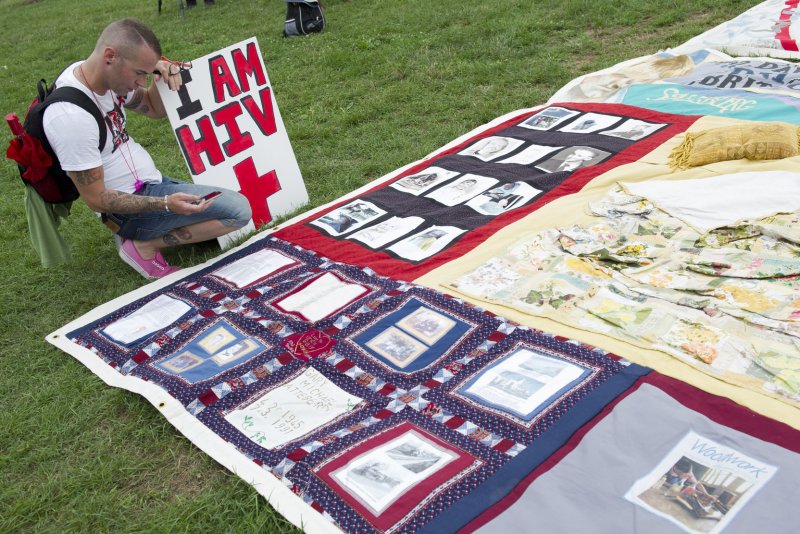1 of 3 | A man photographs a portion of the AIDS Quilt during the Keep the Promise on HIV/AIDS rally celebrating the opening of the International AIDS Conference on the National Mall in Washington, D.C., on July 22, 2012. File Photo by Kevin Dietsch/UPI |
License Photo
Oct. 11 (UPI) -- When the AIDS Memorial Quilt was first unfurled on the National Mall exactly 30 years ago Wednesday -- just six years after the disease was first discovered -- lines of people asked about stitching panels to honor and remember their own loved ones.
Today, the quilt continues to add new tributes and remains one of the most iconic symbols of the epidemic.
"They lined up at our information booth to get copies of our first brochure with instructions for creating memorial-quilt panels," prominent LGBT activist Cleve Jones recalled last year in an op-ed for The Washington Post. "Those brochures would travel back to the home towns of all the visitors. Across America, people began to sew."
Since its unveiling in Washington, D.C., on Oct. 11, 1987, it's the quilt itself that's traveled across America -- and although it hasn't been displayed in full in about 20 years, portions honoring the victims of HIV and AIDS are still seen throughout the United States at theaters, museums, places of worship and other venues. It's become what the Los Angeles Times once called "the most powerful icon in the history of AIDS."
With nearly 2,000 panels and stretching larger than a football field, the AIDS quilt was first displayed during the National March on Washington for Lesbian and Gay Rights three decades ago. Jones -- who first rose to prominence in the 1970s as an aide to San Francisco City Supervisor Harvey Milk -- helped start the NAMES Project Foundation, which maintains the quilt, after hearing in 1985 that AIDS had killed more than 1,000 people in San Francisco alone.
The quilt was a memorial -- and a call to action, he said.
"It could be a tool for the media, to reveal the humanity behind the statistics," Jones wrote in the Post last year. "And a weapon to deploy against the government; to shame them with stark visual evidence of their utter failure to respond to the suffering and death that spread and increased with every passing day."
What was 1,000 in San Francisco in 1985 quickly became 2,000, and skyrocketed in the years that followed.
By the spring of 1988, the quilt bore the names of more than 3,500 people who'd died from AIDS. Already weighing more than three tons, the quilt incorporated momentos like cremated ashes, human hair, sequins and mink fur to remember victims of the epidemic. As the quilt traveled the country, tour officials added even more panels to honor the dead.
By 1996, the Smithsonian had declared the traveling memorial the largest piece of folk art in the United States. By then, the quilt had shown that AIDS did not discriminate by geography -- it bore panels honoring victims from 39 countries. At its last full display in October 1996, the quilt covered the entire National Mall and included more than 31,000 panels.
Today, the AIDS quilt includes nearly 50,000 panels and honors close to 100,000 people -- stretching 1.3 million square feet. Maintaining the memorial is something that the NAMES Project doesn't take lightly, CEO Julie Rhoad told the Georgia Voice earlier this year, upon the opening of a new visitor center in Atlanta.
"We're charged with a responsibility to care for 56 tons of fabric sentiment and love," she said. "That's an enormous responsibility. Memory isn't just a thing of the past. The challenge is making it relevant and teaching it in this day and age, and the Quilt does that in person in ways that many monuments can't."















